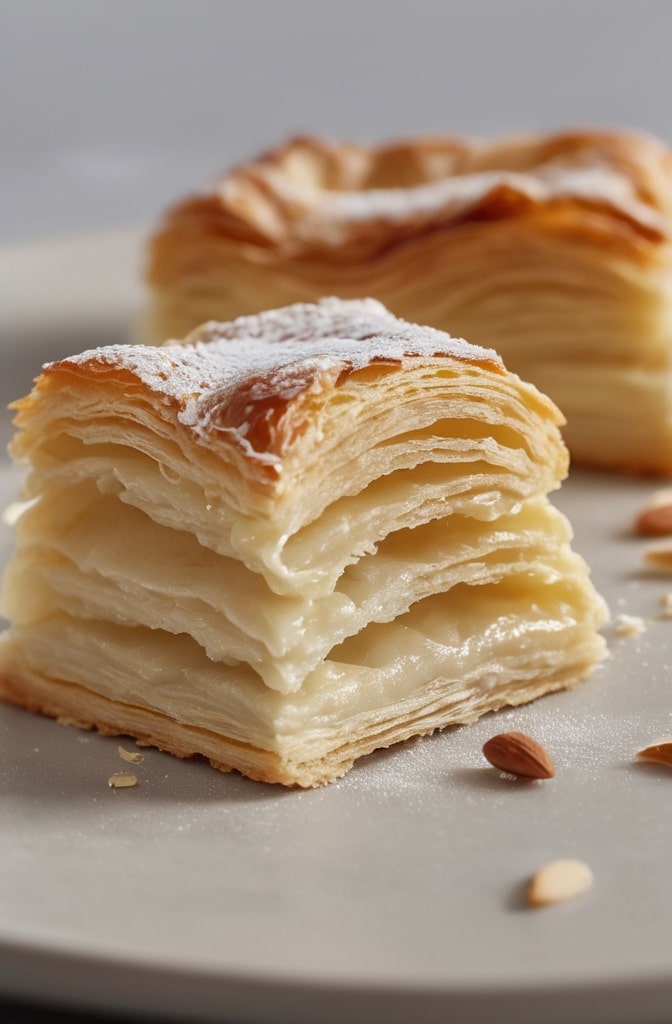Have you ever bitten into a pastry so delicate that it shatters into dozens of buttery shards upon contact? That moment—when the crisp exterior gives way to a rich, nutty almond filling remains one of life’s small culinary treasures. I still remember my first encounter with proper Parisian almond croissants during my apprenticeship years. The contrast between the flaky exterior and the frangipane center haunted me for weeks, eventually inspiring my own Flaky Almond Pastry Treat Recipe, a tribute to those unforgettable bites.
Traditional almond pastries trace their lineage back centuries, with variations appearing across Mediterranean and European baking traditions. What makes these treats special isn’t just their heavenly flavor profile it’s the technical mastery required to achieve that perfect balance between structure and delicacy. Today, I’m sharing my perfected recipe that combines traditional French lamination techniques with a few modern twists that’ll elevate your home baking to professional standards.
1. Ingredients & Substitutions
For the Laminated Dough:
- 500g high-protein bread flour (13% protein content)
- 10g fine sea salt
- 75g granulated sugar
- 14g active dry yeast
- 60ml whole milk, lukewarm
- 120ml water, cold
- 125g unsalted European-style butter, softened
- 250g unsalted European-style butter (for lamination), cold but pliable
European butter contains higher butterfat (82-84%) than standard American butter (80%), which creates those distinctively defined layers we’re after. If unavailable, add 1 tablespoon of crème fraîche to regular unsalted butter and knead together—this boosts the fat content and adds a slight tanginess that mimics the cultured flavor of European varieties.
For those avoidin dairy entirely, coconut oil can work as a substitute, but you’ll loose some flavor complexity and the melting point differs, affecting how the layers form. Another option is a high-quality vegan butter block specifically designed for lamination—these are becomming increasingly available at specialty stores.
For the Almond Filling:
- 200g almond flour (blanched)
- 200g confectioners’ sugar
- 200g unsalted butter, room temperature
- 3 large eggs
- 30ml amaretto liqueur (or 1 tsp almond extract)
- 1 tsp vanilla bean paste
- Pinch of salt
- 50g all-purpose flour
The quality of your almond flour dramatically impacts the final flavor. Look for freshly ground options with a pronounced aroma—many commercial varieties sit on shelves for months, loosing their essential oils and nuanced flavor. If possible, make your own by pulverizing blanched almonds in a food processor, but stop before they release their oils and become butter.
For Assembly and Finishing:
- 1 egg, beaten with 1 tbsp water (for egg wash)
- 100g sliced almonds
- 50g apricot jam, warmed
- Confectioners’ sugar for dusting
2. Step-by-Step Instructions

Preparing the Dough:
- Create the détrempe (basic dough): In a stand mixer fitted with the dough hook, combine flour, salt, and sugar. Whisk together. In a separate bowl, dissolve yeast in lukewarm milk and let sit for 5 minutes until foamy. With the mixer running on low speed, add the yeast mixture, water, and softened butter. Mix 3-4 minutes until a cohesive dough forms, then increase to medium speed and knead for 5-7 minutes until smooth and elastic. The dough shoudl clean the sides of the bowl but still be slightly tacky.
- First rest: Shape the dough into a square approximately 1-inch thick, wrap tightly in plastic wrap, and refrigerate for at least 1 hour or up to overnight. This rest period allows the gluten to relax and the butter to firm up at the same temperature, critical for proper lamination.
- Prepare the butter block: While the dough rests, place the cold lamination butter between two sheets of parchment paper. Use a rolling pin to pound and shape it into an 8×8-inch square of even thickness. Return to the refrigerator until firm but still pliable—about 15 minutes. The butter should be cold but flexible; if it’s too cold, it’ll shatter when folded; too warm and it’ll melt into the dough, preventing distinct layers.
- First lamination (letter fold): Roll the chilled dough into a 12×12-inch square. Place the butter block diagonally in the center to form a diamond shape. Fold the corners of the dough over the butter, overlapping slightly and sealing the edges completely. Roll this package into a 12×24-inch rectangle, keeping edges straight and corners square. Brush excess flour away before completing a letter fold: fold the top third down and the bottom third up, like folding a business letter. Wrap and refrigerate for 30 minutes.
- Second and third laminations: Rotate the dough 90 degrees and roll again into a 12×24-inch rectangle. Complete another letter fold. Wrap and refrigerate for 30 minutes. Repeat this process one more time for a total of three letter folds. Each fold tripples the number of layers, resulting in 27 distinct butter-dough layers after completion.
The most common misstake bakers make is rushing this process. If at any point the butter begins to soften or seep through the dough, immediately return everything to the refrigerator. Maintaining temperature control throughout lamination is absoluteley crucial for achieving that signature honeycomb structure.
Making the Almond Cream (Frangipane):
- In a stand mixer fitted with the paddle attachment, cream butter and confectioners’ sugar until pale and fluffy, about 3-4 minutes on medium speed. Don’t rush this step—proper aeration here creates a lighter filling.
- Add almond flour and salt, mixing until fully incorporated. Add eggs one at a time, ensuring each is fully integrated before adding the next. Finally, add amaretto (or almond extract), vanilla bean paste, and all-purpose flour, mixing just until combined. The mixture should be smooth and hold its shape when scooped.
- Transfer to a piping bag and refrigerate until needed. Cold frangipane is much easier to control during assembly and prevents bleeding into the dough layers.
Assembly and Baking:
- After the final rest, roll the laminated dough to approximately 1/8-inch thickness. Using a sharp knife or pastry cutter, cut into 4×4-inch squares. For traditional crescents, cut into triangles with a 4-inch base.
- For filled squares: Pipe a 1.5-inch strip of frangipane across the center of each square. Fold two opposite corners over the filling, slightly overlapping them, and press gently to seal. For crescents: Pipe frangipane along the base of each triangle, then roll toward the point, curving the ends inward to form a crescent shape.
- Place shaped pastries on parchment-lined baking sheets, leaving 2 inches between each piece to allow for expansion. Brush with egg wash, taking care not to let it drip down the cut edges (this can seal layers together and prevent full rise). Sprinkle generously with sliced almonds.
- Proof at room temperature for 1-2 hours, until visibly puffy but not doubled in size. The ideal proofing environment is around 75°F with 80% humidity. If your kitchen is dry, create a makeshift proofing box by placing a pan of hot water on the bottom rack of your oven (turned off) and the pastries on the middle rack.
- Preheat oven to 400°F (205°C). Just before baking, apply a second light coating of egg wash to the pastries. Reduce temperature to 375°F (190°C) and bake for 18-22 minutes, rotating the pan halfway through, until deeply golden brown. The high initial temperature creates the steam burst needed for maximum rise.
- While still warm, brush pastries with warmed apricot jam for a professional sheen. Let cool on the baking sheet for 5 minutes, then transfer to a wire rack. Once completely cooled, dust with confectioners’ sugar.
For variation, try adding a thin layer of dark chocolate between the dough and frangipane, or fold dried cherries or apricots into the almond cream for bursts of fruity contrast.
3. Cooking Techniques & Science
The magic of laminated dough lies in its creation of distinct layers through the process of repeated folding and rolling. Each time we fold the dough with butter between layers, we’re essentially creating a structure where fat and flour-based dough alternate. During baking, three crucial things happen simultaneously:
First, the water in the butter converts to steam, forcing the layers apart and creating that characteristic puff. Concurrently, the proteins in the flour coagulate, setting the structure before the steam escapes, preserving those air pockets. Finally, the milk solids in the butter brown, developing complex flavors through Maillard reactions.
Temperature control is absolutely critical throughout this process. If your dough becomes too warm during lamination, the butter melts into the dough rather than remaining as discrete layers. This results in a brioche-like texture rather than the distinct flaky layers we’re targeting. Conversely, if the butter is too cold, it becomes brittle and breaks through the dough when rolled, leading to uneven lamination and butter leakage during baking.
The addition of almond cream introduces another dimension of science. The high fat content in the almonds provides richness, while the eggs in the frangipane create a custard-like texture as they coagulate during baking. The all-purpose flour added to the frangipane helps stabilize the mixture, preventing it from liquefying during baking, which would otherwise soak into the dough and prevent proper rise.
A proper laminated almond pastry requires both precision tools and technique. A good-quality rolling pin with adequate weight helps maintain even pressure when rolling. Straight edges for maintaining square corners during folding are invaluable—professional bakers often use dedicated stainless steel rulers for this purpose. And an instant-read thermometer to monitor butter temperature (ideally between 55-65°F) can transform your results from amateur to professional.
4. Serving & Pairing Suggestions
These almond pastries shine brightest when served fresh, ideally within 4-6 hours of baking, though they’ll remain delicious (albeit less crisp) for up to two days stored in an airtight container. For the ultimate experience, warm them slightly in a 300°F oven for 3-4 minutes before serving. This reactivates the buttery aroma and restores some crispness to the exterior.
The complex sweetness and nutty notes of these pastries pair magnificently with several beverage options. Traditional French service would include a small demitasse of espresso or a larger café au lait. The bitter coffee notes create a beautiful counterpoint to the sweet, buttery pastry. For tea drinkers, an Assam or Ceylon black tea provides similar contrast, while a delicate jasmine green tea highlights the floral notes in the almond cream.

For a more luxurious presentation, serve as part of a brunch spread alongside fresh berries mascerated with a touch of Grand Marnier and a dollop of crème fraîche. The acidity from the berries cuts through the richness of the pastry, creating a balanced and sophisticated flavor profile.
When plating for special occasions, consider a quenelle of vanilla bean ice cream alongside a warm pastry, finished with a drizzle of warmed honey infused with lavender or rosemary. The temperature contrast between the cold ice cream and warm pastry creates a sensory experience that elevates the dish beyond mere breakfast pastry to proper dessert status.
Conclusion
Mastering laminated almond pastries represents a significant achievement in any baker’s journey. The process combines precision technique with artistic sensibility, resulting in treats that are as visually stunning as they are delicious. While the steps may seem numerous, remember that each fold brings you closer to that perfect honeycomb structure that defines exceptional viennoiserie.
The key to success lies in patience and temperature control. Never rush the resting periods, and always be willing to pause and refrigerate if your dough or butter begins to warm. Remember that professional bakers often spread this process across two days, allowing the flavors to develop more fully and making the work more manageable.
For troubleshooting common issues: if your layers aren’t distinct, your butter was likely too warm during lamination. If the pastries leak butter during baking, your oven temperature may be too low. And if the pastries don’t rise properly, you may need to extend your final proofing time or check that your yeast is fresh and active.
With practice, you’ll develop an intuitive sense for when the dough and butter are at the perfect temperature and consistency. That intuition, more than any recipe, is what separates good pastries from truly exceptional ones. Master this recipe, and you’ll possess a foundational technique that opens doors to countless other laminated dough creations.
FAQs About Flaky Almond Pastry Treat
Can I make these pastries ahead of time and freeze them?
Absolutely! You can freeze them either before or after baking. For unbaked pastries, shape them completely, then freeze on a baking sheet until solid. Transfer to airtight containers and store for up to 1 month. When ready to bake, allow them to thaw and proof overnight in the refrigerator, then bring to room temperature for 1-2 hours before baking as directed. For baked pastries, cool completely, then freeze without the confectioners’ sugar dusting. Thaw at room temperature and reheat at 325°F for 5-7 minutes, then dust with sugar before serving.
Why did my butter leak out during baking?
Butter leakage typically occurs for three reasons: either your oven wasn’t hot enough when the pastries went in (preventing rapid steam formation), your pastries weren’t properly chilled before baking, or the butter layers became too warm during lamination. Try chilling the shaped pastries for 15-20 minutes immediately before baking, and ensure your oven is fully preheated.
Can I substitute regular flour for the high-protein bread flour?
While you can use all-purpose flour, the lower protein content (typically 10-12%) will result in less structure and potentially fewer distinct layers. If using all-purpose, reduce the liquid by about 15ml to account for the flour’s lower absorption rate, and consider adding 1 tablespoon of vital wheat gluten to boost protein content. The final result will still be delicious but might not achieve quite the same honeycomb structure.
How can I achieve a more pronounced almond flavor?
For more intense almond flavor, toast your almond flour before using it. Spread it on a baking sheet and bake at 325°F for 8-10 minutes, stirring occasionally, until it becomes fragrant and slightly golden. Allow it to cool completely before incorporating it into your frangipane. Additionally, increasing the amaretto to 45ml or using bitter almond extract (use sparingly—just a few drops) will intensify the almond character.
My pastries didn’t rise as much as expected. What went wrong?
Insufficient rise usually stems from either under-proofing or issues with your lamination. Ensure your final proof allows the pastries to become noticeably puffy before baking. The room temperature matters significantly—at 70°F, proofing might take up to 2.5 hours. Also check that your lamination was successful with clear, distinct layers. Finally, verify that your yeast is fresh and active by testing a small amount in warm water with a pinch of sugar—it should foam vigorously within 5-10 minutes.

